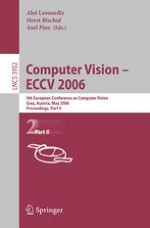2006 | Buch
Computer Vision – ECCV 2006
9th European Conference on Computer Vision, Graz, Austria, May 7-13, 2006. Proceedings, Part II
herausgegeben von: Aleš Leonardis, Horst Bischof, Axel Pinz
Verlag: Springer Berlin Heidelberg
Buchreihe : Lecture Notes in Computer Science
